Solar eclipse of February 26, 1979
| Solar eclipse of February 26, 1979 | |
|---|---|
 Map | |
| Type of eclipse | |
| Nature | Total |
| Gamma | 0.8981 |
| Magnitude | 1.0391 |
| Maximum eclipse | |
| Duration | 169 sec (2 m 49 s) |
| Coordinates | 52°06′N 94°30′W / 52.1°N 94.5°W |
| Max. width of band | 298 km (185 mi) |
| Times (UTC) | |
| Greatest eclipse | 16:55:06 |
| References | |
| Saros | 120 (59 of 71) |
| Catalog # (SE5000) | 9462 |
In astronomy, a total solar eclipse occurred on Monday, February 26, 1979. A solar eclipse occurs when the Moon passes between Earth and the Sun, thereby totally or partly obscuring the image of the Sun for a viewer on Earth. A total solar eclipse occurs when the Moon's apparent diameter is larger than the Sun's, blocking all direct sunlight, turning day into darkness. Totality occurs in a narrow path across Earth's surface, with the partial solar eclipse visible over a surrounding region thousands of kilometres wide. The central shadow of the moon passed through the northwestern U.S. states of Washington, Oregon, Idaho, Montana (where totality covered almost the entire state), the north-central state of North Dakota, parts of the Canadian provinces of Saskatchewan, Manitoba, Ontario, Quebec, and what is now the Canadian Territory of Nunavut, and Greenland.
Visibility
Many visitors traveled to the Pacific Northwest to view the eclipse,[1] since it would be the last chance to view a total solar eclipse in the United States for almost four decades. The next over the United States will be the total solar eclipse of August 21, 2017.
Although the path of totality passed through Portland, Oregon in early morning, it was not directly observable from the Portland area due to overcast skies.[2]
The path of totality passed through Winnipeg, Manitoba in the early afternoon.
Gallery
.gif)
Related eclipses
A partial lunar eclipse occurred on March 13, 1979, 15 days later, visible over Africa, Europe and Asia. A total lunar eclipse followed on September 6, 1979.
Solar eclipses of 1979–1982
Each member in a semester series of solar eclipses repeats approximately every 177 days and 4 hours (a semester) at alternating nodes of the Moon's orbit.
| Descending node | Ascending node | |||||
|---|---|---|---|---|---|---|
| Saros | Map | Saros | Map | |||
| 120 |  February 26, 1979 Total |
125 | 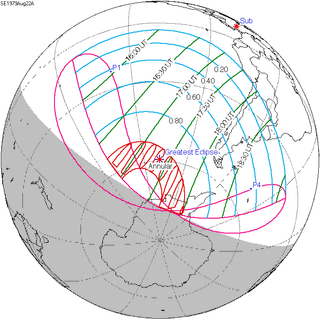 August 22, 1979 Annular | |||
| 130 | 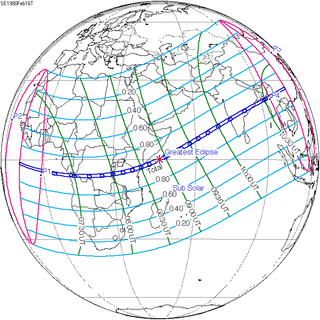 February 16, 1980 Total |
135 |  August 10, 1980 Annular | |||
| 140 |  February 4, 1981 Annular |
145 |  July 31, 1981 Total | |||
| 150 | 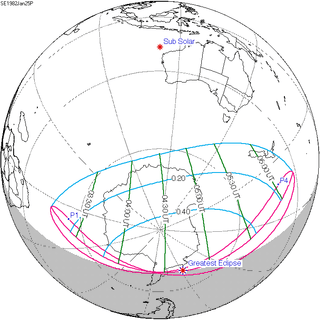 January 25, 1982 Partial |
155 | 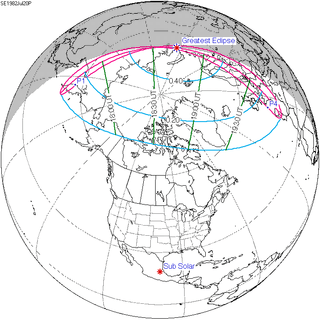 July 20, 1982 Partial | |||
| Partial solar eclipses on June 21, 1982 and December 15, 1982 occur in the next lunar year eclipse set. | ||||||
Saros 120
It is a part of Saros cycle 120, repeating every 18 years, 11 days, containing 71 events. The series started with partial solar eclipse on May 27, 933 AD, and reached an annular eclipse on August 11, 1059. It was a hybrid event for 3 dates: May 8, 1510, through May 29, 1546, and total eclipses from June 8, 1564, through March 30, 2033. The series ends at member 71 as a partial eclipse on July 7, 2195. The longest duration of totality was 2 minutes, 50 seconds on March 9, 1997.[3]
| Series members 55–65 occur between 1901 and 2100 | ||
|---|---|---|
| 55 | 56 | 57 |
 January 14, 1907 |
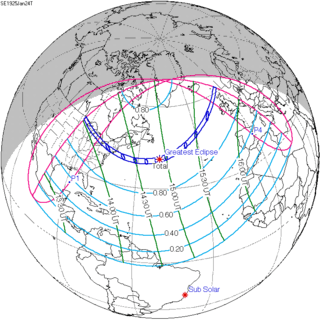 January 24, 1925 |
 February 4, 1943 |
| 58 | 59 | 60 |
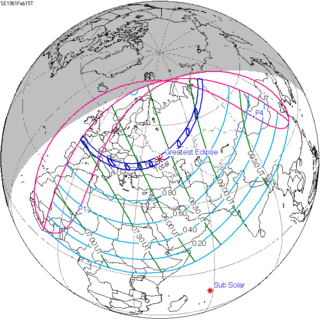 February 15, 1961 |
 February 26, 1979 |
 March 9, 1997 |
| 61 | 62 | 63 |
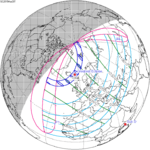 March 20, 2015 |
 March 30, 2033 |
 April 11, 2051 |
| 64 | 65 | |
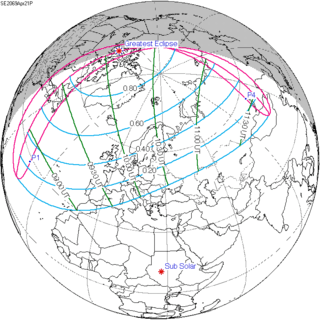 April 21, 2069 |
 May 2, 2087 | |
Metonic cycle
The metonic series repeats eclipses every 19 years (6939.69 days), lasting about 5 cycles. Eclipses occur in nearly the same calendar date. In addition the octon subseries repeats 1/5 of that or every 3.8 years (1387.94 days).
| 21 events between July 22, 1971 and July 22, 2047 | ||||
|---|---|---|---|---|
| July 21-22 | May 9-11 | February 26-27 | December 14-15 | October 2-3 |
| 116 | 118 | 120 | 122 | 124 |
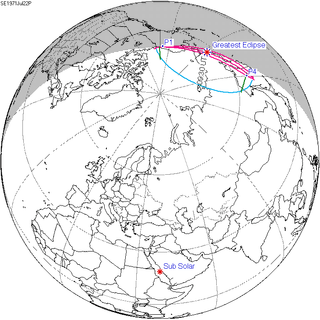 July 22, 1971 |
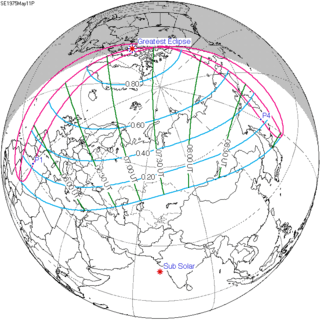 May 11, 1975 |
 February 26, 1979 |
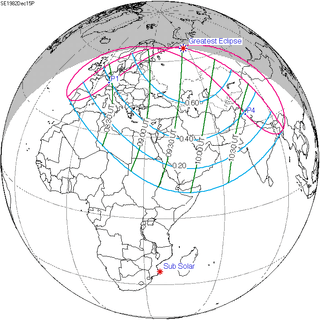 December 15, 1982 |
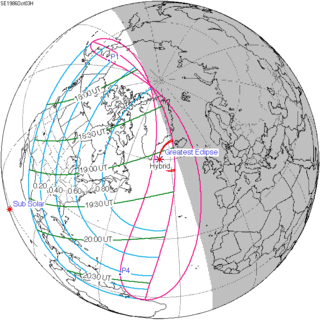 October 3, 1986 |
| 126 | 128 | 130 | 132 | 134 |
 July 22, 1990 |
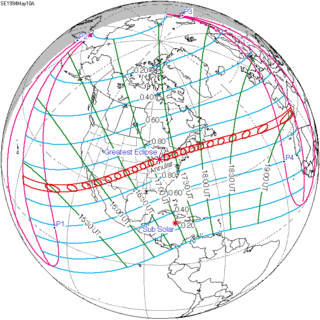 May 10, 1994 |
 February 26, 1998 |
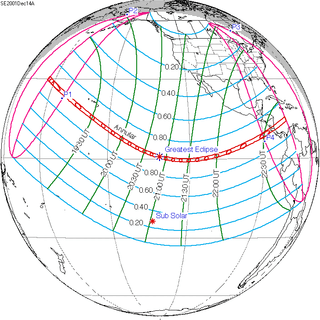 December 14, 2001 |
 October 3, 2005 |
| 136 | 138 | 140 | 142 | 144 |
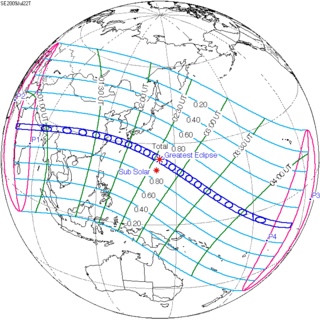 July 22, 2009 |
 May 10, 2013 |
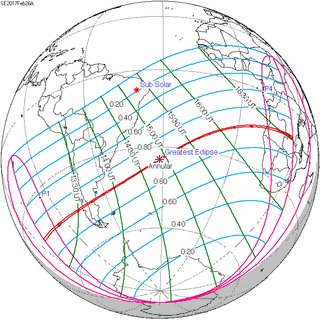 February 26, 2017 |
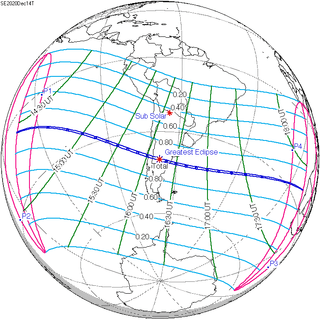 December 14, 2020 |
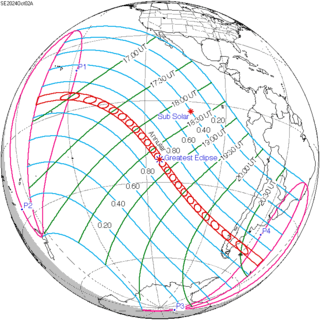 October 2, 2024 |
| 146 | 148 | 150 | 152 | 154 |
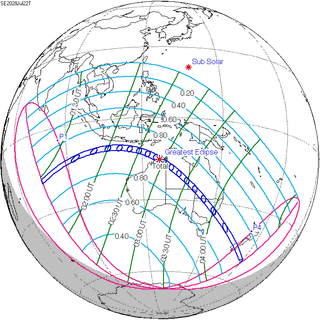 July 22, 2028 |
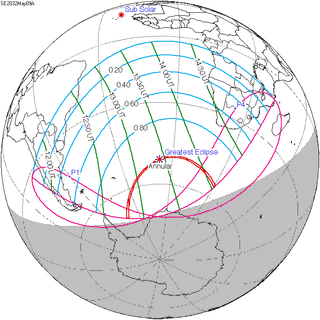 May 9, 2032 |
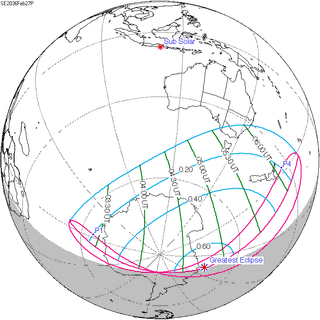 February 27, 2036 |
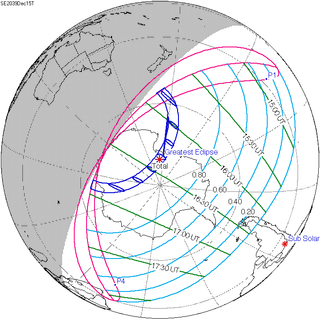 December 15, 2039 |
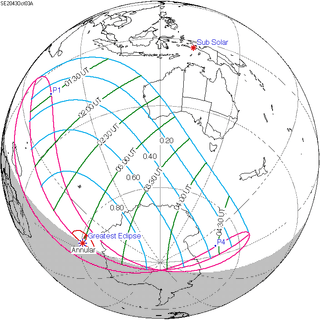 October 3, 2043 |
| 156 | ||||
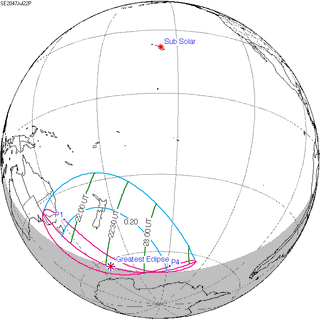 July 22, 2047 | ||||
Notes
- ↑ "Eclipse chased across Northwest". Daytona Beach Morning Journal. New York Times. February 27, 1979. p. 1A.
- ↑ "Thick clouds hide eclipse from many". Eugene Register-Guard. Associated Press. February 26, 1979. p. 1A.
- ↑ http://eclipse.gsfc.nasa.gov/SEsaros/SEsaros120.html
See also
References
- Earth visibility chart and eclipse statistics Eclipse Predictions by Fred Espenak, NASA/GSFC
- eclipse.org.uk Total Eclipse of the Sun: 1979 February 26
- Predictions for the 1979 solar eclipse Royal Astronomical Society of Canada, Journal, vol. 72, June 1978, pp. 149–161 Fred Espenak
Photos/observations:
- Eclipse Chaser's Journal: Part 1, My First Total Solar Eclipse: February 26. 1979, Jeffrey R. Charles
- http://nicmosis.as.arizona.edu:8000/ECLIPSE_WEB/ECLIPSE_79/ECLIPSE_79.html
- 1979 Solar Eclipse – ABC News Coverage Excerpts from an ABC News Special Report that aired at 11:00–11:29 a.m. EST on Monday, Feb. 26, 1979
- 1979 Total Solar Eclipse Report on CBS News with Walter Cronkite The February 26, 1979 total solar eclipse story as reported on the CBS Evening News with Walter Cronkite.
- Solar Eclipse Photo Gallery 1, 1970 – 1984 Fred Espenak
- Solar eclipse 1979, Manitoba, Canada
- Portland, Oregon, February 26, 1979
| Wikimedia Commons has media related to Solar eclipse of 1979 February 26. |
